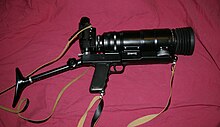Chronophotographic shotgun
The chronophotographic shotgun (also known as the photographic rifle ) is an invention of the French physiologist Étienne-Jules Marey in 1883, which allowed objects to be viewed and photographed in space.
Eadweard Muybridges (actually Edward James Muggeridge ) movement studies in Animal locomotion (1877) and The Human Figure in Motion were created in elaborate experimental arrangements with initially 12, later 24 and finally up to 30 cameras. The chronophotographic shotgun reduced this effort by capturing a whole series of exposures on a single plate. An improved version of the chronophotographic shotgun developed later could even record a separate image for each phase of movement.
Marey's invention was based on the astronomical revolver by the French astronomer Pierre Jules César Janssen from 1874.
The chronophotographic shotgun, the chronophotographic projector ( 1889 ) and Muybridge's zoopraxiskop (1879) are considered to be the immediate precursors to the invention of the cinematograph .
More photographic rifles
In the Soviet Union , the Krasnogorsk camera works manufactured a photo rifle under the name Photosniper or Fotosniper with different variants from the mid-1960s . However, it was not a chronophotographic camera, but a special, portable telephoto reflex camera with shoulder tripod , pistol grip and large focal length.


